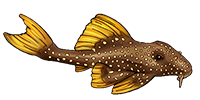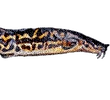Chiloglanis cameronensis
- Yann
- Posts: 3617
- Joined: 30 Dec 2002, 20:56
- I've donated: $20.00!
- My articles: 8
- My images: 275
- My cats species list: 81 (i:0, k:0)
- My BLogs: 2 (i:3, p:81)
- Spotted: 109
- Location 1: Switzerland
- Location 2: Switzerland
- Interests: Catfish mainly form South America, Cichlids, Geckos, Horses WWII airplanes, Orchids
Chiloglanis cameronensis
Hi!
I might be able to get a few Chiloglanis cameronensis.
What are the basic requirement for them.
Water: parameters, waterflow...
Food: any special food needed...
Behavior: solitarian or group...
Calm or agressive towards other tank mates!!!
In advance thanks!
Cheers
Yann
I might be able to get a few Chiloglanis cameronensis.
What are the basic requirement for them.
Water: parameters, waterflow...
Food: any special food needed...
Behavior: solitarian or group...
Calm or agressive towards other tank mates!!!
In advance thanks!
Cheers
Yann
Don't Give Up, Don't Ever Give Up!
- Silurus
- Posts: 12478
- Joined: 31 Dec 2002, 11:35
- I've donated: $12.00!
- My articles: 55
- My images: 903
- My catfish: 1
- My cats species list: 90 (i:1, k:0)
- Spotted: 433
- Location 1: Singapore
- Location 2: Moderator Emeritus
They need well-oxygenated water (should be soft and acidic). Strong current is very much preferred.Water: parameters, waterflow...
Algae should be provided. You should also feed them live/frozen food. My <i>Chiloglanis</i> (a different species, <i>C.</i> cf. <i>disneyi</i>) would also eat micropellets with a little difficulty.Food: any special food needed...
The pair of <i>C.</i> cf. <i>disneyi</i> (this was a sexually dimorphic species) I kept generally got along well with each other, although I noticed a little pushing and shoving sometimes. There should be no problems keeping more than one.Behavior: solitarian or group...
They won't bother other fish, but should not be kept with boisterous tankmates.Calm or agressive towards other tank mates!!!

- Dinyar
- Posts: 1286
- Joined: 31 Dec 2002, 00:34
- My articles: 3
- My images: 226
- My catfish: 10
- My cats species list: 3 (i:10, k:0)
- Spotted: 94
- Location 1: New York, NY, USA
- Interests: Mochokidae, Claroteidae, Bagridae, Malepteruridae, Chacidae, Heteropneustidae, Clariidae, Sisoridae, Loricariiadae
My experience (with C. cf. neumanni) and advice is mostly similar to but in some ways slightly different from Silurus'.
1) Well oxygenayed, CLEAN water, strong current. C. cameronensis comes from soft waters, but other Chiloglanis spp. come from hard to very hard waters, so no genus-wide recommendations can be made with regard to pH and KH.
2) Like all Mochokids that I have kept, Chiloglanis are ominovores. They may well browse aufwuchs, but I have never seen mine eating algae. I feed mostly freeze-dried bloodworms and freeze-dried brine shrimp, and they eat these with great enthusiasm. I'm sure they would enjoy live foods that were small enough, but I have never fed these, and they seem to be fine without them.
3) I would recommend keeping a larger group of them together in a well-stocked community tank of mostly small, peaceful fish and lots of plants. Why well-stocked? IME, this will help ensure that no food is wasted, Chiloglanis like clean water and are too small to eat much themselves. 50% water changes weekly.
Finally, these are somewhat delicate fish. Once established, they are quite hardy, but I experienced 100% loss when I kept the first batch in a small, bare quarantine tank for a week. The next batch I introduced directly into a large, crowded community tank with no quarantine and had 100% survival.
In summary: clean, well oxygenated water with strong current, mature aquarium, and diet of small worms and crustaceans.
Great fish! Very sociable and active, and very fun to watch.
Dinyar
1) Well oxygenayed, CLEAN water, strong current. C. cameronensis comes from soft waters, but other Chiloglanis spp. come from hard to very hard waters, so no genus-wide recommendations can be made with regard to pH and KH.
2) Like all Mochokids that I have kept, Chiloglanis are ominovores. They may well browse aufwuchs, but I have never seen mine eating algae. I feed mostly freeze-dried bloodworms and freeze-dried brine shrimp, and they eat these with great enthusiasm. I'm sure they would enjoy live foods that were small enough, but I have never fed these, and they seem to be fine without them.
3) I would recommend keeping a larger group of them together in a well-stocked community tank of mostly small, peaceful fish and lots of plants. Why well-stocked? IME, this will help ensure that no food is wasted, Chiloglanis like clean water and are too small to eat much themselves. 50% water changes weekly.
Finally, these are somewhat delicate fish. Once established, they are quite hardy, but I experienced 100% loss when I kept the first batch in a small, bare quarantine tank for a week. The next batch I introduced directly into a large, crowded community tank with no quarantine and had 100% survival.
In summary: clean, well oxygenated water with strong current, mature aquarium, and diet of small worms and crustaceans.
Great fish! Very sociable and active, and very fun to watch.
Dinyar
- Yann
- Posts: 3617
- Joined: 30 Dec 2002, 20:56
- I've donated: $20.00!
- My articles: 8
- My images: 275
- My cats species list: 81 (i:0, k:0)
- My BLogs: 2 (i:3, p:81)
- Spotted: 109
- Location 1: Switzerland
- Location 2: Switzerland
- Interests: Catfish mainly form South America, Cichlids, Geckos, Horses WWII airplanes, Orchids
- Silurus
- Posts: 12478
- Joined: 31 Dec 2002, 11:35
- I've donated: $12.00!
- My articles: 55
- My images: 903
- My catfish: 1
- My cats species list: 90 (i:1, k:0)
- Spotted: 433
- Location 1: Singapore
- Location 2: Moderator Emeritus
- Dinyar
- Posts: 1286
- Joined: 31 Dec 2002, 00:34
- My articles: 3
- My images: 226
- My catfish: 10
- My cats species list: 3 (i:10, k:0)
- Spotted: 94
- Location 1: New York, NY, USA
- Interests: Mochokidae, Claroteidae, Bagridae, Malepteruridae, Chacidae, Heteropneustidae, Clariidae, Sisoridae, Loricariiadae
I'm not recommending this necessarily, but I keep mine with my Hypancistrus at 28 C. They don't seem to be bothered by the high temperature.
I chose this tank because it has lots of current and high oxygenation. (Unlike a real Xingu biotope, it also has quite a few plants). I usually prefer to keep biotopically correct tanks, but my West and Central African tanks house large Synos and don't have high current or lots of plant cover.
Overall, I think that if the O2 level and current are adequate, the temperature is secondary. Higher temps may actually confer some protection against ich, which Chiloglanis seem susceptible to.
Dinyar
I chose this tank because it has lots of current and high oxygenation. (Unlike a real Xingu biotope, it also has quite a few plants). I usually prefer to keep biotopically correct tanks, but my West and Central African tanks house large Synos and don't have high current or lots of plant cover.
Overall, I think that if the O2 level and current are adequate, the temperature is secondary. Higher temps may actually confer some protection against ich, which Chiloglanis seem susceptible to.
Dinyar




